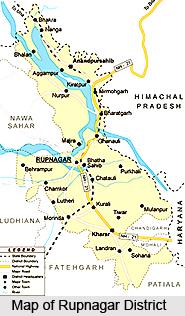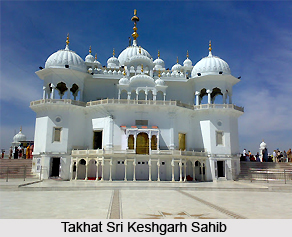 Rupnagar District, included in the Patiala Division of Punjab falls between north latitude 30 degree 32 minutes and 31 degree 24 minutes and east longitude 76 degree 18 minutes and 76 degree 55 minutes. Rupnagar (formerly known as Ropar) town, the district headquarters is 42 kms from Chandigarh. The district adjoins Nawanshahr, Mohali and Fatehgarh Sahib Districts.
Rupnagar District, included in the Patiala Division of Punjab falls between north latitude 30 degree 32 minutes and 31 degree 24 minutes and east longitude 76 degree 18 minutes and 76 degree 55 minutes. Rupnagar (formerly known as Ropar) town, the district headquarters is 42 kms from Chandigarh. The district adjoins Nawanshahr, Mohali and Fatehgarh Sahib Districts.
History of Rupnagar District
Rupnagar District has rich historical and religious significance behind it. Formerly known as Ropar, the town of Rupnagar is said to have been founded by a Raja called Rokeshar, who ruled during the 11th century and named it after his son Rup Sen. The town is of considerable antiquity. Recent excavations and explorations conducted at Rupnagar indicate that the first civilized folk to settle here were the Harappans, who apparently reached the upper Sutlej. According to the history of Rupnagar District, it was carved out on 1st November, 1966 at the re-organization of the state.
Geography of Rupnagar District
The climate of Rupnagar District is characterized by its general dryness (except in the south-west monsoon season), a hot summer and a bracing cold winter. The year is generally divided into four seasons. The period from mid November to February is the cold season. This is followed by the summer season from March to the end of June. The south-west monsoon season commences late in June and continues up to about middle of September. The period from mid September to the middle of November constitute the post-monsoon or transition season. The temperature ranges from minimum of 4 degree Celsius in winter to 45 degree Celsius in summer. May and June are generally hottest months and December and January are the coldest months. Relative humidity is high. The average annual rainfall in district is 775.6 mm. About 78 percent of the annual rainfall is received during the period from June to September. Geography of Rupnagar District contains soils that vary in texture generally from loamy to clayey except along Sutlej River where some sandy patches may be found. In some areas, soils are undulating.

Administration of Rupnagar District
Administrative set-up of Rupnagar District comprises four tehsils namely Rupnagar, Anandpur Sahib, Nangal and Chamkaur Sahib. The two sub-tehsils of Rupnagar District are Morinda and Nurpur Bedi. Further, administration of Rupnagar District comprises five development blocks - Anandpur Sahib, Chamkaur Sahib, Morinda, Nurpur Bedi and Rupnagar. It includes 624 villages and six towns namely Rupnagar, Chamkaur Sahib, Anandpur sahib, Morinda, Kiratpur Sahib and Nangal. All the towns except Chamkaur sahib fall on railways line.
Tourism in Rupnagar District
Tourism in Rupnagar District mainly includes holy shrines and Gurudwaras. It is one of the popular tourist places and is known for its pilgrimage sites. The main religious attractions of Rupnagar District are Takhat Sri Keshgarh Sahib, Jateshwar Mahadev Temple, Gurudwara Parivar Vichhora Sahib, Gurudwara Bhatta Sahib and Gurudwara Sadabarat. Bhakra Nangal Dam and the place of treaty between Maharaja Ranjit Singh and Lord William-Bentick are other tourist attractions offered by Rupnagar District.
Rupnagar District is also popular for its fairs and festivals. Holla Mohalla, Shaheedi Jor Mela and Shivaratri Fair are some of the major fairs that draw the attention of large number of people from all parts of the state.






